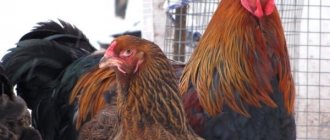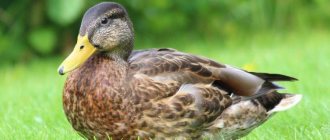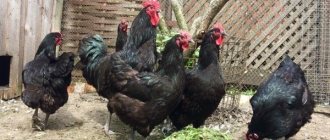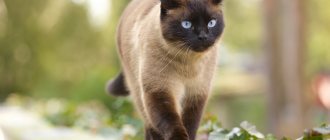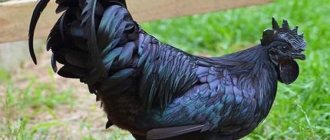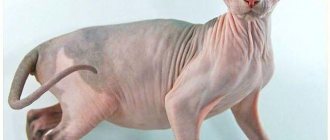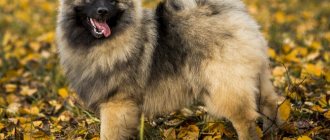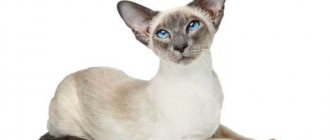Many poultry farmers are thinking about owning Faverol chickens. Chickens are known for their docile nature, tasty meat and high egg production. From this article you will learn about the main types of the Faverol breed and signs of non-breeding, about the feeding and maintenance features of such birds, and read reviews of people who kept this breed. All this will help you decide whether the Faverol breed is right for you.
Characteristics and description of the breed
Five-fingered chickens are raised for show only in most countries.
Beautiful, stately chickens with a beard and sideburns are a suitable decoration for the owner’s yard, but elegance is not their only advantage. Initially, the breed was considered meat-oriented (the meat is tender, juicy, white, fine-fiber), but currently egg production is rapidly gaining momentum (up to 160-180 large eggs, up to 60 grams). The eggshell is dense, brownish-pink, brownish in color.
Description of chickens of the Faverol breed:
- Weight – 2-3.5 kg for a chicken, 4-5 kg for a rooster (dwarf Faveroli weigh about 1 kg);
- The head is small, slightly flattened, flat in nature;
- Small but powerful beak, white, pale yellow or pinkish in color;
- The comb is of medium size, simple format, with uniformly carved high teeth, erect, leaf-shaped, low;
- The neck is medium in size, dense, with lush plumage;
- The eyes are medium in diameter, reddish-orange in color;
- The face is covered with red skin and is moderately pubescent. There is a characteristic beard under the beak; red lobes are covered with sideburns. Earrings are not fully developed.
- The body, set horizontally, is slightly elongated, trapezoidal in shape, with a massive, heavy chest and well-developed muscles. Long back, turning into a powerful, dense loin with rich plumage.
- Deep belly;
- Raised tail with short tail feathers;
- The wings are located high on the body and fit tightly;
- Well-developed legs, with abundant feathering, low shins, no spurs (hawk tuft), medium-length metatarsals, white, a special feature of the breed - five toes;
- The bones are thin;
- The skin has a white, creamy white color;
- The feather is a tight fit, the plumage is luxurious, soft, loose;
- The color is multifaceted (the most typical are salmon and silver).
Chickens Faverolles
You can distinguish a rooster from a chicken by the following differences:
- Faverolle roosters have brighter plumage than laying hens;
- the male has larger body parameters, according to the parameters his body is square, the hen’s body is rectangular;
- chicken has a more squat, overweight constitution;
- Chickens have a roof-shaped tail, while roosters have short, curved braids.
Not many people know how to distinguish the sex of Faverolle chickens, and not everyone can do it with accuracy.
It is possible to distinguish hens from cockerels only two months after hatching:
- the cockerels have a beard and sideburns, the feathers on the tips of the wings are noticeably darker than those of the hens;
- hens fledge faster than cockerels;
- the comb of males grows faster, has a more intense color, and their paws are larger;
- cocky behavior of cockerels.
Important! The Faverolle chicken does not have a pronounced brooding instinct; it cannot be used for breeding offspring.
Advantages and disadvantages
This is a meat breed that grows and fattens well. The quality of their meat is above average. Chickens, despite being a meat type, produce a sufficient number of eggs. They can lay eggs even in winter in a chicken coop where the temperature drops below 10°C, but not below 0°C. One of the advantages of the breed is its decorativeness.
The disadvantages found in Faverolles are the following:
- chickens have almost no brooding instinct, so the chickens will have to be hatched in a home incubator;
- high price for eggs and young animals.
We recommend reading
Review of the Kuchin Jubilee breed of chickens and features of their maintenance
Description and productivity characteristics of the Pavlovsk breed of chickens
Description and productivity characteristics of the Pavlovsk breed of chickens
Features of feeding broilers at home
Method 4 “Ventsexig” or “Japanese”
Without professional skill, it is better not to undertake this method of determining the sex of one-day-old babies. The essence of the method is based on the difference in the structure of the genital organs. In the anus, very close to the surface, in cockerels a small genital tubercle is formed, which is not present in hens. Currently, most European and all Japanese factories use this method, since its accuracy is 92-98%.
Ventsexig has side effects. Often, with rough intervention, the thin mucous membrane of the cloaca is injured, infections are introduced - as a result, the chicken gets sick and dies before it reaches the age of one week. The method is effective for several hours after hatching. But in one hour, up to 800 babies can be checked in this way, if you have sufficient dexterity. So, let's look at the description of the method:
Remove feces
The chick's abdomen is carefully squeezed with three fingers of the left hand over a special container for feces. If it is liquid and not all is removed, you need to wipe the anus with a cotton swab. Fix the chicken
To do this, the chick is taken with all five fingers of the left hand and turned upside down. Lightly hold the head, spread the legs with the right hand and fix them. The cloaca is opened. At the same time, spread the hole and press on the tummy towards the legs, carefully inspect the hole for the presence of a genital tubercle.
Possible problems during cultivation and their solutions
Little Faveroli are distinguished by good health and endurance.
Growing pains are usually the result of mistakes made when:
- selection of birds for breeding;
- incubating eggs;
- caring for young animals.
The main cause of age-related problems lies in too rapid increase in body weight and much slower development of the heart, internal organs, and skeleton.
This discrepancy may cause:
| Disease | Description and method of struggle |
| Ascites | It occurs when the heart does not have time to pump blood, which leads to the accumulation of fluid in the abdominal cavity, suffocation, and death of the bird. Prevention:
|
| Limb deformity | A skeleton that is not fully formed cannot withstand the weight load, which leads to curvature of the legs. The bird loses the ability to move and soon dies from exhaustion, dehydration, or is trampled by its fellows. The main way to avoid this problem is:
|
Young animals are also not immune from diseases characteristic of adult Faverolles. Obesity, intestinal infections, parasites for young chickens can have more serious consequences. The main way to prevent such problems is cleanliness, the ability to move, a properly composed diet, according to the description, recommendations and photographs.
Breed characteristics
Representatives of the Faverolles chicken breed, like true French women, have a very attractive appearance. Faverolles hens in any herd can be distinguished by the characteristic frame on the head (whiskers) and the feathering on the legs in the form of panties.
The beak of chickens of this breed is short, but extremely strong, white or pink. Adults are distinguished by a simple and vertically oriented comb with high teeth. The color of the pupils in males and females is orange-red.
The neck of typical representatives of the breed is of medium length and covered with a kind of mane. The tail is not long and slightly raised, the tail feathers are short and covered with curved braids of short length. The chest, like the belly, of classic representatives of the breed is deep and wide, the wings are located quite high and fit snugly to the body
This is perhaps what you should pay attention to when describing the exterior of the Faverol breed chickens
But Faverolle chickens are not bred for their beauty. According to reviews, the meat of these chickens is valued by gourmets for its tenderness and very refined taste, which makes it possible to serve dishes from it in the most respectable restaurants on the planet. With thin bones and good live weight, Faverolle chickens sell very well for any kitchen.
The Faverolle chicken breed is a precocious breed, i.e., a fast-growing breed for meat production. Average egg production is approximately 180 eggs in the first year of laying and 130 eggs in the second year. The eggs of laying hens of this species have a strong yellow or brown shell; The minimum weight of one egg is 60 grams.
The weight of a rooster can reach four kilograms, and a hen up to three and a half kg. Faverol chickens are very frost-resistant, however, they are often prone to obesity. The character of chickens is calm, even somewhat phlegmatic.
Breeding Faverolles
The Faverolle chicken breed is usually bred using an incubator, but females have maternal instinct and can sit on eggs. For breeding, eggs are taken from hens one year of age or older. And for the eggs to be fertilized, it is necessary that there are approximately 5 females per rooster in the chicken coop.
Hens have maternal instinct and can sit on eggs
Important!
Inbreeding can lead to degeneration of the breed, the appearance of defects, and deformities in chicks. For this reason, professional breeders divide the herd into different pens according to age.
After birth, chicks are usually raised in a brooder. They grow quickly, gain weight well and usually do not get sick if the brooder is clean and high-quality, nutritious food is fed. At first, the chickens are given a boiled egg and steamed corn porridge. From day 5 you can include chopped greens and vegetables, bran, and yeast in your diet. From 2 months, birds should already eat whole grains and crushed corn. You can also give feed for young animals. At 3 months, the young animals move into the main herd.
Chickens grow quickly, gain weight well and usually do not get sick
How to feed chickens
The diet is complete, otherwise there will be a lack of vitamins and minerals and the birds may develop a wide variety of diseases. Every day they need to be given dry grain and wet mash of greens and root crops and vegetables. With normal feeding, the female produces approximately 2 eggs in 3 days. If productivity is lower, then feeding needs to be improved.
To simplify this task, use simple feed. But it is not cheap, it is much more profitable to give simple feed - grain and mash, adding crushed chalk, meat and bone meal, silage, vegetable cake, premixes.
For normal digestion, there should be a bowl with crushed shells, gravel and sand in the chicken coop and on the run. Drinkers are installed on the run and in the chicken coop so that the birds can always drink enough. It is best to change the water every day so that it does not stagnate, does not get dirty and is always fresh.
In winter, instead of greens, you can give herbal flour or herbal granules
Important! In winter, instead of greens, you can give herbal flour or herbal granules. Silage or sprouted grain may also be a good alternative.
Reviews from poultry farmers
★★★★★
Alexander, 47 years old, Domodedovo. I recommend it to everyone who chooses poultry for the taste of meat, health and beauty.
Excellent character, communicates well with children. Egg production is good, my 5 hens usually produce 3 eggs a day. Chicks are born strong. ★★★★★
Elena, 54 years old, Moscow region. The breed is calm and tame.
Excellent foragers. I let them free range, both the beds and flower beds are intact. They help me loosen the berry patches under the bushes. Laying hens produce 2 eggs in 3 days each. In general, the reviews are only positive. ★★★★★
Sergey, 52 years old, Kiev. Soon I will say goodbye to the fireball.
Not very impressed, it turned out to be a difficult breed. Some have no meat, only bones, others get fat quickly. Very late ripening, they breed at about 8-9 months, at the same age roosters become adults. They don't carry very well. No meat, no eggs - at least for me. And there is a lot of hassle. But beautiful, of course, stately. Calm, good at grazing, like geese, good hens. It is worth starting for those who want to seriously engage in them and take part in exhibitions. I would get a different breed for farming, but decide for yourself. Hide
Add your review
There is a lot of information about Faverolle chickens, but reviews from poultry farmers vary. It is quite difficult to buy a real bird of the Faverol breed, and the price increases with the age of the individual. Accidentally purchasing a crossbred instead of a purebred bird is most likely the reason for negative reviews of the breed. Those who are luckier report high egg production, tasty meat and ease of maintenance. But many agree that chickens of this breed are beautiful, have a good character and become attached to the owner.
0
0
Copy link
The fifth reason is gastronomic
If the first four reasons are not enough, then there is another reason to fall in love with this breed of chicken - white tender meat, which has a rich taste and fine-fiber structure. In France, restaurateurs especially value free-range faverolles: their meat is more aromatic and tastes like pheasant.
The carcass of a 4-month-old cockerel has a very appetizing appearance, has a large breast with thin and light bones
Firewood meat at the age of 6-7 months is just as tender and juicy, and cooks in the same time as that of young broilers. Another significant advantage of the breed is that there is no need to singe the carcass; feathers are plucked easily and quickly.
In France, there are still dishes that are prepared exclusively from poultry of this breed.
We offer a recipe for one of the simple traditional dishes of Faverolles - tender chicken breasts for a festive feast.
Ingredients:
- chicken breast (fillet) – 4 pcs.;
- apple (large) – 2 pcs.;
- mushrooms (champignons) – 200 g;
- Calvados (apple vodka) and sour cream - 6 tbsp each. l.;
- butter – 50-70 g;
- salt and pepper - to taste;
- greens (parsley) – 1 bunch.
Cooking algorithm:
- Salt and pepper the breasts.
- Melt the butter in a frying pan, fry the meat over high heat on both sides until half cooked (about 10 minutes), place on a plate.
- Cut the apples into slices (4-6 parts) and core them.
- Add oil to the pan and fry the apples until a crust forms. Add them to the chicken.
- Fry the mushrooms (large ones can be cut into pieces first) over high heat, stirring, for 3-5 minutes.
- Add meat and apples to the mushrooms and heat.
- Pour Calvados into the pan and set it on fire. After the flame goes out, add sour cream little by little, mixing the ingredients with the sauce. Reduce heat and simmer for another 10 minutes.
- Place on a plate and sprinkle with finely chopped parsley.
Boiled potatoes, rice or homemade noodles are perfect as a side dish for this delicacy (and don’t forget to pour dry red wine into the glasses!).
Briefly about the origin
Throughout its existence, the Faverol breed was constantly modified. To increase the weight of the bird, it was crossed with large meat breeds - Brama, Cochin, Dorking. Almost all the time, breeders were focused on the productivity of the breed.
Only when Faverol came to England did breeders begin to improve its appearance. This was done so that the bird could be used as an exhibition specimen.
Faverol owes its standard color to German specialists, because they developed the salmon variety. After this, black, white and even blue Faveroli began to appear. The Germans also brought out dwarf Faverolles, weighing no more than a kilogram.
Conditions of detention
Faverol chickens tolerate cage and aviary housing quite negatively. The ability to easily gain weight requires physical activity.
Walks
A wide, free range is suitable for these purposes; there is no need to fence it high, since chickens are very lazy in this regard. Chickens making such walks have the opportunity to obtain pasture (food of plant origin), rich in microelements, vitamins and minerals, due to which their egg fertility and immunity increase.
Wide, free range
Attention! The productive qualities characteristic of the breed are preserved by isolating Faverolles from representatives of other breeds
Chicken coop
Chickens need a spacious coop
The floor is covered with dry bedding, and air humidity is kept under strict control (they do not tolerate high humidity). The danger of disease increases when birds are overcrowded, so it should not be allowed
To prevent birds from scattering food, feeders are hung or special partitions are made in feeding containers. The perches are equipped with ladders for climbing.
Diet
Birds are given only fresh, balanced and healthy food. The presence of proteins and proteins is mandatory (they have a positive effect on the level of egg production of laying hens and the growth of the young generation). The main feeding consists of: grain (150 g per head), a variety of root vegetables, grass, vitamin flour and suitable waste from the owner's table. In winter, greens are replaced with sprouted wheat.
Important! A poor diet, lack of microelements and vitamins will lead not only to a decrease in egg production and growth. Pterophagy is also possible - when birds begin to pluck each other’s feathers to compensate for the lack of substances, this causes significant damage to the farm, in most cases the bird dies
Diseases
Faverol chickens are quite resistant to diseases. The greatest danger comes from growing in conditions of high room humidity and damp litter. Failure to meet optimal conditions causes disease and death of the bird. Chickens are susceptible to worms and mites. For the purpose of prevention, a large container with ash is installed in the chicken coop so that the bird can easily clean its feathers. Prevention of worms is carried out once a year.
Breeding
According to the description of poultry farmers, Faverol chickens have practically lost the instinct to breed offspring. Therefore, hatching is possible using an incubator or another hen. In rare cases, a Faverol hen can sit on eggs, but it is not at all a fact that she will hatch them. For better reproduction, keep 5-6 hens and 1 rooster. In this case, the male must be of a different breed line, otherwise inbreeding will lead to the appearance of defects in the offspring and degeneration of breed characteristics. The best time for breeding is February. Faverol chicks hatch on the 22nd day.
It is recommended to observe the following nuances:
- Eggs from hens that are at least one year old are suitable for breeding;
- Egg storage duration is no more than 14 days at a temperature not exceeding +10 degrees;
- the temperature regime of the incubator is strictly at +37.6°C, any jump leads to anomalies;
- hatched chicks are kept in a room with a temperature of at least 38 degrees Celsius, with dry, warm bedding;
- on cloudy, dark days, and periods of short daylight hours, additional artificial lighting is used.
Feeding the chickens
From birth they give finely chopped boiled eggs, cottage cheese, and corn porridge. After 10 days, complete chicken feed is introduced: within a month - up to 6-8 times, then for another month they are fed 4 times, and after that they switch to 3 feedings a day.
Features of maintenance and care
It is recommended to raise Faverolle chickens using the floor method. There should be approximately 4-5 chickens per square room. Comfortable perches are made in the chicken coop at a distance of 50-60 cm from the floor, but a ladder is placed on them so that the birds can easily reach their sleeping place. They also set up nests for laying hens, a place for feeders and drinkers. It is advisable to install a basin with sand and ash for cleaning feathers.
Comfortable perches are made in the chicken coop at a distance of 50-60 cm from the floor
Dampness and drafts are unacceptable. It is necessary to ensure ventilation, good lighting and warmth in the room (preferably heating). The bedding is made of straw, sawdust or peat, in a layer of 10-15 cm. This breed requires cleanliness due to its abundant plumage and feathered legs. So cleaning is carried out every day and once a week the litter needs to be partially replaced, removing dirt.
Important!
Faverolles chickens are prone to obesity. If you do not need to fatten them for meat, then it is worth providing the bird with daily walks in the fresh air. Such physical exercises will allow them not to gain excess weight and avoid illnesses.
The bedding is made of straw, sawdust or peat, in a layer of 10-15 cm
The walk is spacious. If there is not enough space in the chicken coop or on the run, egg production will decrease - chickens of this breed are very sensitive to cramped conditions. If it is not possible to have a walk, you can simply let the chickens out into the garden for walks. These chickens usually do not dig, so the crops will not be damaged. And since this breed does not fly, chickens do not need a large fence.
Faverol, chicken breed: description, photo
Representatives of the fireball breed can be distinguished from other inhabitants of the poultry yard by their harmonious physique, characteristic feather color and the presence of 5 toes on their paws, while other chickens have 4.
As for the description of appearance, it has the following features:
- the head is small in size and flattened, slightly flat in shape;
- the beak is not long, maybe white, pink or even light yellow;
- the comb is medium in size, stands straight, has the shape of a leaf with uniform teeth;
- the cervical region is compact, the length is normal, the neck is decorated with lush feathers that extend to the back - such a unique collar can be called a characteristic feature of the fireroll, some of the feathers are located in the horizontal plane, and some are in the vertical plane and are directed towards the back of the head;
- the eyes are medium in size and orange-red in color;
- the face has red skin covered with a small amount of fluff, the earlobes are scarlet, there are sideburns and a beard under the beak, the earrings are completely undeveloped;
- the body is slightly elongated and resembles a trapezoid, the position is horizontal, the chest is heavy, the muscles are well developed, the dorsal region is elongated with a transition to a well-developed lumbar part, the back is covered with fluffy integumentary feathers - birds have a deep belly, if we compare laying hens and breeders, the former have more stocky and massive constitution;
- the tail feathers are raised, the tail feathers are short, roosters have curved braids, and chickens have a roof-shaped tail;
- wings are high and fit tightly to the body;
- limbs with short legs, well feathered, with white metatarsals - the highlight of French chickens is the presence of a fifth finger ending in a long claw, placed above the hind finger, the fourth finger has a horizontal placement;
- The feathers of fireworts are soft, lush, slightly loose; thanks to the abundant feather cover, the birds tolerate frost well;
- skeletal bones are thin, the skin of chickens, regardless of the variety, is white and creamy in color;
- chicks are born with yellow, white-yellow fluff; it will be possible to distinguish males and females by gender from the 60th day (cockerels grow a beard and sideburns, and the feathers at the ends of the wings become darker);
- This breed has a variety of colors; typical colors include salmon and Colombian (silver).
History of breeding
Chickens of the Faverol breed were bred in the 18th century. To obtain this species, 5 breeds were taken (Brama, Manta, Gudan, Dorking, Cochin). The breed was officially registered in 1886. By the end of the 19th century it was widespread throughout France. It was one of the best views at that time. At the same time, Faverols were brought to Russia, and they appeared in America only in the 20th century.
On the neck there is a visible mane of loose feathers, smoothly flowing into the back. There is a distinct collar at the base of the head
Later, in England, exhibition chickens were first bred and the external characteristics of the bird were determined - its standard. And German breeders improved the productivity of the species, while maintaining the decorative nature of the breed.
Characteristic
The description of the breed suggests that among other chickens, fireballs are distinguished by their proportional body structure, special feather cover and unusual paws. Their head is small and flat. The beak is pale yellow or pinkish. The mane is of normal size, smooth and set fairly low. The neck is small, strong and large, with a magnificent crest that goes all the way to the back.
The bird's plumage is arranged in various ways. The eyes are small, red with an orange tint. Her earrings are not fully developed. The trapezoidal body is slightly elongated.
The approximate weight of a chicken ranges from 2 to 3.5 kg. The weight of a rooster can be 4-5 kg. The chest is large and strong. The back is slightly elongated. It is adjacent to a strong and strong loin, on which a large number of feathers are located. Chickens' bellies are large and full.
The body structure of birds is heavy and massive. The tail rises upward. The main feathers are small in size. Roosters have short, curved braids. The tail is roof-shaped. The wings are located quite high and adjoin very close to the body. The shins of birds are short, but well formed. The legs are covered with thick feathers. The sole is white with a normal size.
The plumage of chickens is beautiful and delicate. In winter, fireballs are not at all cold due to the fact that they have a lot of feathers. The base of the body is thin. Creamy white skin. The chicks are born with a golden coat. The sex of the chick cannot be seen immediately. Only after 2 months can significant differences be found. Cockerels have a visible beard, and the feathers become darker than those of hens. They can be of different colors. The most popular colors are salmon and silver.
What kind of breed
The homeland of chickens of this breed is France, but the description first appeared in the 18th century. Faverol chickens were noted for their first-class meat, which produces a high-quality, rich broth.
In the 19th century, crossings of Faverolle chickens with other breeds, mainly meat, began. Since then, Faverol began to be considered a meat breed. From 1866 there is a name that has survived to this day. This bird was valued for its unpretentiousness, combined with excellent taste.
Gradually, the breed gained popularity far beyond the borders of France, including in the New World. In Russia, it also became known, but a little later, towards the end of the 19th century. In England, breeders came up with the idea of slightly modifying the appearance of the breed’s chickens so that they could participate in exhibitions. The Germans just developed the salmon variety, which is the standard.
Identifying chickens
There are several methods to find out the sex of a chicken. But each of them gives no more than 80% accuracy. So the risk that he will grow into a rooster and not a hen, or vice versa, is still quite large. But then how do they carry out culling at poultry farms, because there the accuracy is 100%. How were they able to achieve this?
How to distinguish chickens in poultry farms
There, the problem of determining gender is solved very quickly and simply. The fact is that factory chickens are crosses specially bred for production. Thanks to selection, already at one day of age they have excellent sexual characteristics, which are expressed in the color of the chicken. That is, all beige chickens are hens, and white ones are future roosters.
You can also find information on poultry breeding forums that back in Soviet times, some poultry farms used one experimental method. It also gave 100% accuracy. They say that it involved the use of ultrasounds. They selected an ultrasound that would attract the hens and scare away the cockerels, or vice versa.
Then all the livestock gathered in a large area or in a large room. There were speakers on one side and they emitted this ultrasound. The floor they were luring gathered around them, and the rest crowded further away, namely against the opposite wall. Poultry farmers could only redistribute the chickens into cages.
Chicken color
By the color of the fuzz of chickens, you can accurately determine the sex not only of factory crosses. There are breeds of chickens that are called autosex. That is, sexual differences manifest themselves from the very first days. These breeds include: Legbar, Leghorn, Rhode Island, Italian Partridge, Silver Adleria, etc. Thus, in most of these breeds, day-old cockerels have a striped color, and the hens are uniformly white, gray or black.
If we talk about other breeds, then each has its own characteristics. For example, brahma hens have clear stripes on their backs and clear dots on their heads, while cockerels have blurry stripes. You can recall in more detail the breeds of Rhode Island and New Hampshire. On the second day of life, dark spots and stripes on the head are clearly visible in females, while in males they are absent.
As you can see, there is no single correct distinction for all breeds. Some have males that are more colored, while others have females. But if the breed is autosex and you know what color each should have, then distinguishing a cockerel from a hen will not be difficult. Therefore, if you want to buy chickens on the market, it is better not to rush and look for literature for a more detailed acquaintance with the proposed breed.
We distinguish by the wing fan
Another method that works well in practice. But unfortunately, it is not 100% accurate. But this method is also used quite often. It consists in the fact that the female’s wing fan should be red with a white tip. And males have a white spot in the middle of the wing.
Japanese method
Another one hundred percent method for determining the sex of chickens already at 15 hours of age. The fact is that cockerels have a small genital tubercle near the cloaca. Females do not have it. Making a diagnosis is very simple. You need to take the chicken and carefully examine the area around the cloaca. If you find a characteristic tubercle, it’s a male, and if not, then it’s a female.
Another interesting method
This method, although not 100% accurate, has a very impressive accuracy of more than 70%. It involves taking the chicken by the legs and lifting it upside down. If it is a chicken, then it will hang with its head down. Well, if there is a cockerel in front of us, then he will try to raise his head. But at what age this method works most effectively, opinions among poultry farmers differ. Therefore, decide for yourself whether it is worth using it.
Gender test: on the left is a cockerel; on the right is a chicken
Diet
In order for chickens to develop normally, they need to be provided with a balanced diet. The bird's diet must include:
- Sources of calcium. Sources of calcium include bone meal, fish meal, crushed shell rock, crushed eggshells, and chalk. It is worth noting that crushed eggshells are not the best option, since chickens can recognize an egg in it, which will subsequently provoke pecking. Chalk is also not an ideal source of calcium, since if consumed frequently, it can clump in the gastrointestinal tract and lead to blockage.
- Mash. They are very good because they contain all the elements necessary for chickens. The mash can be cooked in meat broth; you can add table salt, vegetables, cereals, grains, etc. to them.
- Cereals. Grains are the basis of a chicken's diet. Grains should account for at least 50% of the food consumed. They can be given either whole or crushed. In addition, many poultry farmers practice feeding sprouted grains. It should be given to the bird when its egg production is unsatisfactory. Cereals are best given in the morning and evening.
- Yeast. They need to be included in the diet only when the chicken is lagging behind in development and needs to gain weight.
- Fresh grass. Fresh grass is a good source of nutrients for chickens. In addition, fresh grass will significantly reduce the costs associated with feeding poultry.
Variety of suits
Salmon faverolles are also called lahschüners. Here there are some differences between males and females. Chickens have feathers that are red-pink in color with a snow-white border. The belly and sternum are decorated with feathers of a lighter shade. This color is called salmon. The feathers have a white shaft. On the tail and neck there are brick feathers with a reddish tint. The predominant color on the belly and sternum is snow-white.
Roosters boast charcoal, brick, whitish and amber speckled feathers located on the sternum, belly, wattle, sideburns, and tail. The back is decorated with ivory-colored feathers. The feather collar is covered with emerald-black or copper-brown shiny stripes.
For further reproduction, it is not recommended to use birds with the following disadvantages:
- males without red feathers in the first order, as well as on the back, without colored spots on the cervical collar, with an excessively mottled belly, with no beard, without white specks on the belly and sternum;
- females that do not have a salmon color, with the presence of black feathers in the beard.
It is important! Breeders who have only brown spots on the neck collar are selected for selection. This feature helps preserve the purity of the breed.
According to the standard, fireballs can have the following suits:
- blue;
- salmon blue;
- white;
- ermine;
- fawn;
- black;
- berken (light – birch);
- splash;
- white-red;
- striped.
As for the silver color, there are no differences in color between hens and roosters. The tail and mane along the feather shaft have blue-black stripes and an emerald tint. Feathers along the contour with a white border. According to the standard, the tail feathers of hens and the large braids of roosters should have the same border.
The flight feather is black with white trim. When the bird folds its wings, the black color is no longer noticeable. Feathers in the second order, as well as down, have no inclusions.
The following are subject to culling:
- hens and roosters with a gray pattern;
- faverolle with solid black feathers on the mane, yellow plumage.
The white suit is characterized by the presence of a pure white color in both males and females.
Blue - a feather of blue color, there may be different color intensities with an outlined outline of the feather.
Signs indicating a breed defect:
- Individuals with underdeveloped muscles, as well as those with a short, squat, very tall body that does not have a trapezoidal shape are subject to culling. This also includes chickens with a convex or arched dorsal region, a sharp and narrow rear half of the body.
- Four-fingered birds, chickens with non-standard coloring of the metatarsus (blue, yellow), incorrect position of the toes (5 and 4), with a yellow beak, a large comb, long tail feathers and too prominent pads in the area of the rump do not take part in breeding work.
- A short, narrow neck, insufficient feathering of sideburns and beard, with cuffs on the metatarsals, and lack of feathering (hairstyle) on the head of chickens are also considered defective.
Signs of poor breeding
It is very important to monitor the purity of the Faverol breed. The offspring obtained from mixing with other breeds of chickens will be less hardy than the previous generation, and in the future may lose their characteristics.
The main sign of poor breeding of a Faverol hen or rooster is underdeveloped muscles. A very squat or, conversely, very tall body, a thin or insufficiently long neck, an uneven back (for example, too arched), a long sharp tail - all this leads to the culling of birds from the pedigree herd.
It is also worth paying attention to the paws: birds without a fifth toe, with a “hawk’s heel”, or with an incorrect position of the fourth and fifth toes will not be able to pass standardization.
The absence or insufficient size of a chicken's hairstyle, and slight plumpness of plumage on the neck and sides of roosters are also a sign of poor breeding. A yellow beak, a disproportionate crest, and an excessive number of feathers on the metatarsals indicate a mixed breed.
Conditions of detention
Faverole chickens do not tolerate aviaries and cages well. Birds that gain weight quickly need conditions to express physical activity.
Free range
When free-ranging, fireworts get sick much less often and have a high percentage of egg fertilization, since they have the opportunity to obtain microelements, vitamins, and minerals thanks to pasture.
Owners appreciate firebirds for their tact, because when searching for insects, these birds do not destroy flower beds and beds. They don't like to fly. In this regard, there is no need to create high fences for walking
It is important to consider that in order to preserve the productive qualities and distinctive characteristics of these birds, they should be kept isolated from representatives of other breeds
Chicken coop structure
Favoroles should be planted in a spacious chicken coop. Inside, you need to provide the birds with dry bedding, and also monitor the air humidity. It should be as dry as possible, since fireball chickens do not tolerate high humidity.
Crowding of birds should also not be allowed. When a chicken coop is densely populated, there is a risk of disease. This also leads to an increase in feed consumption, and chickens begin to trample it. To avoid this, feeders are suspended or crossbars are created in the feeding boxes to prevent the “residents” from throwing food around.
To avoid possible fractures when falling from a height, wide round perches are made, equipped with a ladder for climbing.
Faverol is a disease-resistant breed. Birds are very unpretentious. The main danger is the high humidity of the chicken coop air and litter. If the optimal maintenance regime is violated, the bird quickly becomes ill and dies.
Characteristic diseases of the breed
If the maintenance and nutrition of chickens of this breed are organized correctly, they will rarely get sick or not at all. The worst thing for this breed is wet bedding in the chicken coop. It spreads diseases that cause the death of chickens.
Another enemy of this breed is obesity, which significantly reduces egg production and also slows down the growth of chickens. The representatives of this breed themselves have excellent immunity - this is the merit of the breeders
Chickens should not have the opportunity to come into contact with wild birds - this poses a risk of infection with helminths and skin parasites. To prevent these diseases, chicken rooms should have baths filled with ash and sand.
Molting, in fact, is not a disease, it is a natural process, but chickens sometimes experience it painfully. They lose their appetite, hide, sit motionless, and stop laying eggs. Most often this happens in the fall. This process should go through on its own, but it is better to help the bird by enriching the diet with vitamins and microelements.
